Ernest Lawrence’s ‘Paradise of Physics’ a Smashing Success
by Lynn Yarris
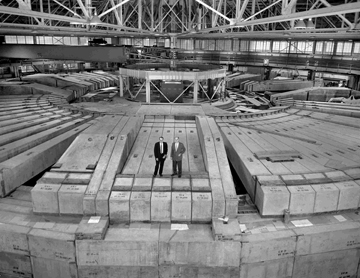
Edwin McMillan, left, and Edward Lofgren on the shielding of the Bevatron.
When World War II ended in 1945, U.S. troops returned home and America got busy rebuilding. The post-war effort will probably be most remembered for a monumental boom in the number of births. Between the years 1946 and 1958 more than 70 million babies would be added to the population. These “boomers” would come of age during the 1960s and wield a tremendous impact on politics and culture that continues to be felt. But the 1950s belonged to the parents of these boomers and they, too, made quite an impact. The United States and the Soviet Union engaged in a “Cold War” of competing ideologies as both raced for nuclear arms hegemony. World War II’s top general, Dwight D. Eisenhower, became president and cautioned the citizenry against the military-industrial complex. A vaccine was developed that saved children from the crippling ravages of polio, and a group of clergymen, led by Martin Luther King Jr., formed the Southern Christian Leadership Conference to rid society of the scourge of racial discrimination. The era began with families gathered at night around the radio and ended with them glued to their televisions, as Uncle Miltie and Howdy Doody replaced the Green Hornet and Lux Theater. The New York Yankees dominated baseball, Rocky Marciano and Sugar Ray Robinson dominated boxing, Marlon Brando and James Dean dominated the silver screen, Elvis Presley dominated the recording industry, and, in the hills overlooking the UC Berkeley campus, a laboratory led by an American genius of Norwegian extract dominated the world of science.
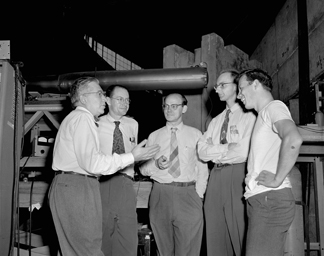
From left, Emilio Segrè, Clyde Wiegand, Edward Lofgren, Owen Chamberlain and Thomas Ypsilantis.
Rad Lab director Ernest O. Lawrence had not waited for the end of the war to plan for his laboratory’s future. His vision called for the creation of “a paradise of physics,” and with the advantage of establishing a big laboratory prior to wartime, he seized the day. Lawrence was one of the first to recognize that as a result of the Manhattan Project, a new compact between science and government had been forged. Whereas before the war, Lawrence’s dreams had been financed through the generosity of philanthropists, now he would look to the federal government, primarily the newly formed Atomic Energy Commission. Though the focus of the AEC was on nuclear science, Lawrence’s skillful negotiations and salesmanship led to financial support for a broad spectrum of interdisciplinary research, and his being remembered as “the Father of Big Science.”
One of Ernest Lawrence’s first big successes — outside what others might have considered to be the natural domain of the AEC — came when he convinced the agency to provide support for the radiopharmaceuticals research programs led by his brother, John Hundale Lawrence. A graduate of Harvard Medical School, John, who was four years younger than Ernest, joined his older brother at Berkeley in 1935 after teaching at Yale, where he studied the effects of radiation on the pituitary gland. The idea was to conduct biomedical studies with the products of Ernest’s newly developed cyclotron. John had become interested in the potential use of cyclotron-produced radioisotopes and nuclear radiation in the treatment of cancer when, with Paul Aebersold, he discovered that a beam of neutrons had a much more destructive effect on tumors than an equivalent dose of x-rays. In 1936, John Lawrence founded the Donner Laboratory within Ernest’s Rad Lab and in 1937 he used the radioisotope phosphorus-32 to successfully treat polycythemia vera, a bone marrow disorder. In 1939, he used beams of energized neutrons to treat a patient with leukemia, the first treatment of cancer with beams from a particle accelerator.

Melvin Calvin conducts his Nobel Prize-winning photosynthesis research.
Following the end of the war, with access to the Rad Lab’s mighty new 184-Inch Synchrocyclotron, and backed by AEC funding, John Lawrence and a star-studded team that included Joseph Hamilton, Cornelius Tobias, Hardin Jones and Will Siri, literally launched the field of modern nuclear medicine. Among their many accomplishments were the use of particle beams to successfully treat acromegaly, Cushing’s disease, and several other conditions, the production of long-lived radioisotopes to label hemoglobin in red blood corpuscles and demonstrate that iron is transported to the bone marrow by a protein, and the measurement of the life-span of red blood cells. With Siri, John Lawrence also made expeditions to the Andes to study red cell production at high altitudes. This research led to studies of erythropoietin, the hormone that controls the production of red blood cells. In 1948, John Lawrence was named by Ernest to be the Rad Lab’s first Associate Director.
On Sept. 2, 1945, the day of the Japanese surrender, Ernest Lawrence is reputed to have told biochemist Melvin Calvin that it was “time to do something useful with radioactive carbon.” When carbon-14, a radioactive isotope of carbon-12 was discovered in 1940 at the 60-Inch Cyclotron by Martin Kamen and Samuel Ruben, scientists immediately recognized its potential use as a “tracer,” a substance that can be tagged to organic molecules and used to follow the fate of those molecules through different stages of a chemical process. With a half-life of 5,700 years, carbon-14 was ideal for tracing biochemical processes. The process that most interested Calvin and Lawrence was photosynthesis, the means by which green plants are able to convert sunlight into chemical energy. Photosynthesis had first been identified by the German physicist Julius Robert von Mayer in 1845, but even by 1946, all scientists really knew for certain is that carbon dioxide and water went into a plant and oxygen came out.
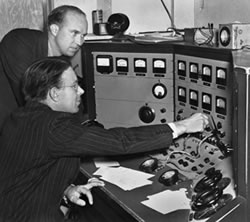
John Lawrence, above, with brother Ernest at the controls of the 60-Inch Cyclotron.
Working out of Lawrence’s original Rad Lab building on campus, Calvin organized a team of researchers to map the chemical path that carbon travels through a plant during photosynthesis, starting from its absorption as atmospheric carbon dioxide to its conversion into carbohydrates and other organic compounds. The team used carbon-14 as the tracer, plus new ion exchange techniques, paper chromatography and radioautography. Over the next few years, in the process of creating their map, Calvin and his team showed that sunlight acts on the chlorophyll in a plant to fuel the manufacturing of organic compounds, rather than on carbon dioxide as was previously believed. The chlorophyll uses radiant energy to split water molecules into hydrogen and oxygen. Separated, hydrogen and oxygen contain more chemical energy than they do combined as water. For leading the research that deciphered the photosynthetic process, Calvin would receive the 1961 Nobel Prize in chemistry.

Emilio Segrè, who shared a 1959 Nobel Prize with Owen Chamberlain.
Pushing the boundaries of the periodic table continued to be a Rad Lab priority after the war, and a “Hot Lab” was established under the leadership of Glenn Seaborg, whose team included nuclear chemists Albert Ghiorso, James Kennedy and B. B. Cunningham. For their discoveries of neptunium and plutonium, respectively, the first two elements beyond the 92 naturally occurring elements, Seaborg and Edwin McMillan shared the 1951 Nobel Prize in chemistry. Following that joyous occasion, Seaborg and his “Hot Lab” team would go on to discover nine other elements plus numerous isotopes. They would also confirm the concept of the actinides, a heavy version of the rare earth elements.
For all its successful ventures into disciplines other than particle physics, the Rad Lab of the 1950s remained first and foremost a physics laboratory, and in the 1950s, the biggest prize in physics research was the antiproton. The story began in 1928, when British physicist Paul Dirac proposed the existence of antimatter, the mirror image of normal matter with positive electrons and negative protons. Dirac’s idea was greeted with skepticism until 1932, when the antielectron was discovered. The hunt for the antiproton had begun, but it got off to a very slow start because to capture an antiproton, scientists would first have to make one. This required that a beam of protons be accelerated to 6 billion electron volts of energy, then smashed into a stationary atomic target. Even the Rad Lab’s mighty 184-Inch Synchrocyclotron fell far short of this mark, and that machine had pushed the energy limits of cyclotron technology. However, as the Rad Lab entered the 1950s, there was new hope.
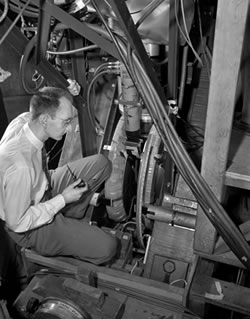
Owen Chamberlain at the Bevatron.
After the war, McMillan had returned to the Lab to work on overcoming the energy limitations of cyclotron accelerators. He came up with the idea for a new type of accelerator, based on a principle called “phase stability” that he independently co-discovered with Soviet physicist Vladimir Veksler. Applying this principle would yield a new type of accelerator in which particles would be locked in step with accelerating energy pulses, making it feasible to accelerate them virtually any number of times. This new type of accelerator, which has become the standard instrument of high-energy physics research today, was called a “synchrotron.”
The plans for the Rad Lab’s next big accelerator began in 1948, but they underwent a number of changes through 1951.
Ernest Lawrence and McMillan were well aware of the energy needed to produce an antiproton and they made certain their new accelerator would surpass that threshold. Construction was completed in January 1954 and the new machine, a synchrotron designed to accelerate protons up to energies of 6.5 billion electron volts, then designated BeV (now universally known as GeV), was christened the “Bevatron.”
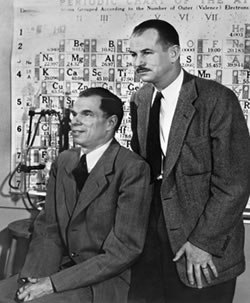
Glenn Seaborg, left, and Edwin McMillan, who shared a 1951 Nobel Prize.
With a machine that had the energetic muscle to make antiprotons, Lawrence and McMillan put together two teams to go after the elusive particle. One team was led by Edward Lofgren, who managed operations of the Bevatron. The other was led by Emilio Segrè and Owen Chamberlain. The antiproton experiments of the Segrè and Chamberlain team began the first week of August 1955. Their first run on the Bevatron lasted five consecutive days. Lofgren and his collaborators ran their experiments the following two weeks. The Segrè and Chamberlain group returned on Aug. 29 and ran until the Bevatron broke down on Sept. 5. On Sept. 21, a week after operating crews had revived the Bevatron, Segrè and Chamberlain got their first evidence of the antiproton based on momentum and velocity. Subsequent analysis of emulsion stack images by Rad Lab colleague Gerson Goldhaber confirmed the discovery.
For leading the discovery of the antiproton, Segrè and Chamberlain shared the 1959 Nobel Prize in physics, joining Ernest Lawrence, McMillan and Seaborg as Rad Lab laureates, with Calvin soon to follow. It was a record of institutional achievement without precedent, but the driving force behind this historical accomplishment did not live to see it. Throughout the spring of 1958, Ernest Lawrence had been suffering from a serious recurrence of his chronic colitis. Against medical advice, he honored the request of President Eisenhower to attend talks in Geneva with the Soviet Union about a ban on nuclear weapons testing. The trip proved too much for his failing health. Lawrence was rushed back to the Stanford University hospital for surgery. During his final days, he confided to his wife, Molly, “I wish I’d taken more time off. I would have liked to, you know, but my conscience wouldn’t let me.” He died on Aug. 27, 1958, at the age of 57. Just 23 days after his death, the UC Regents voted to rename the Rad Lab as the Lawrence Berkeley Laboratory. An American genius and giant of science had passed away, but for the laboratory that now bore his name there was still much to come.